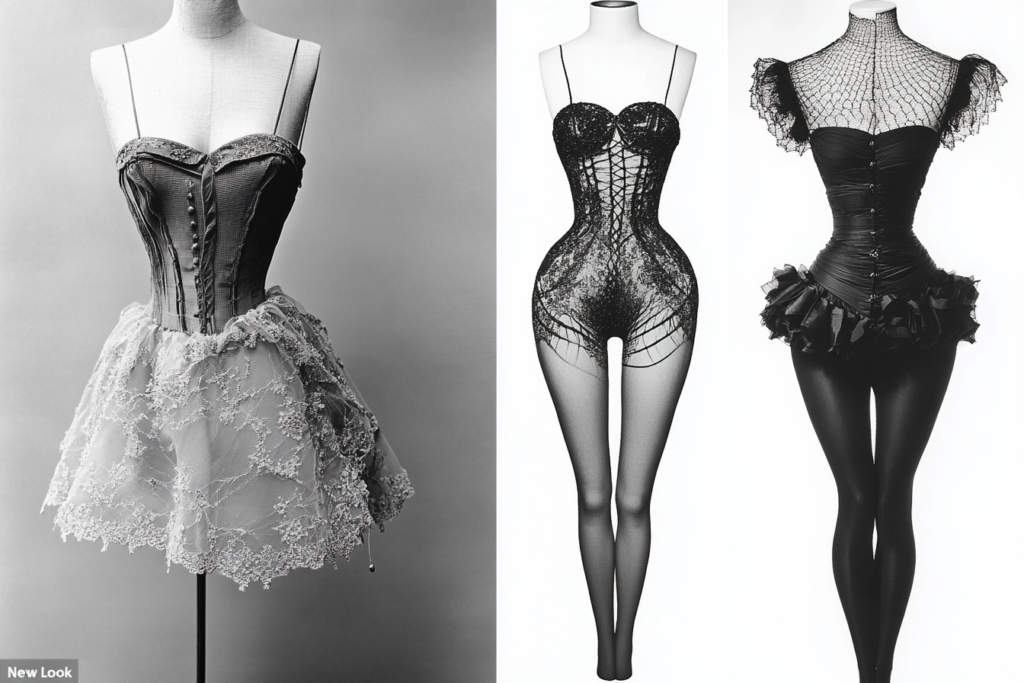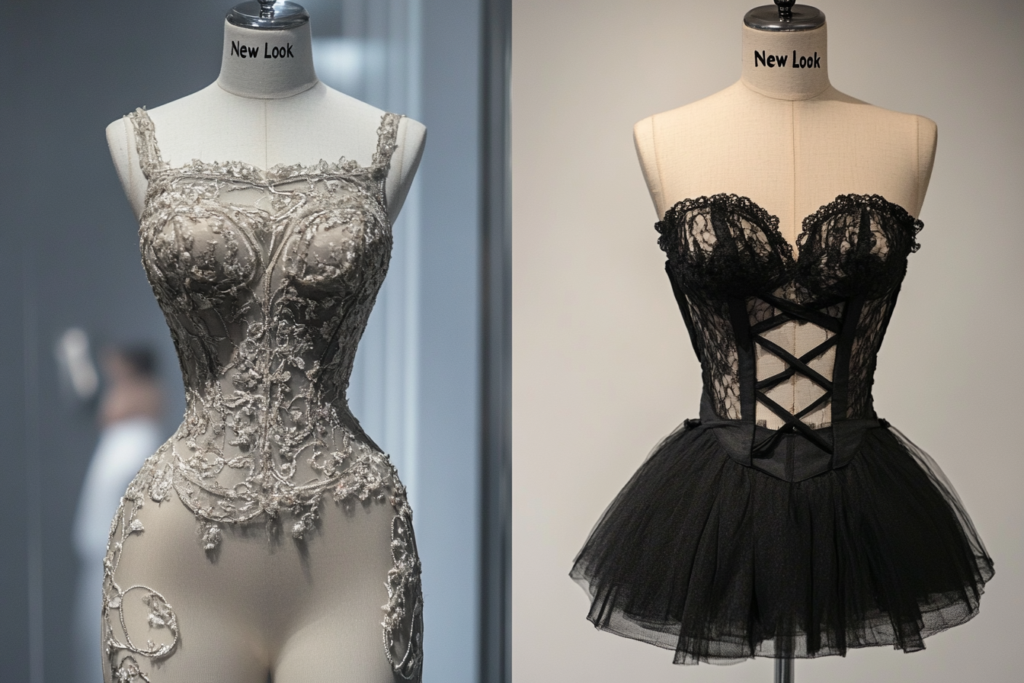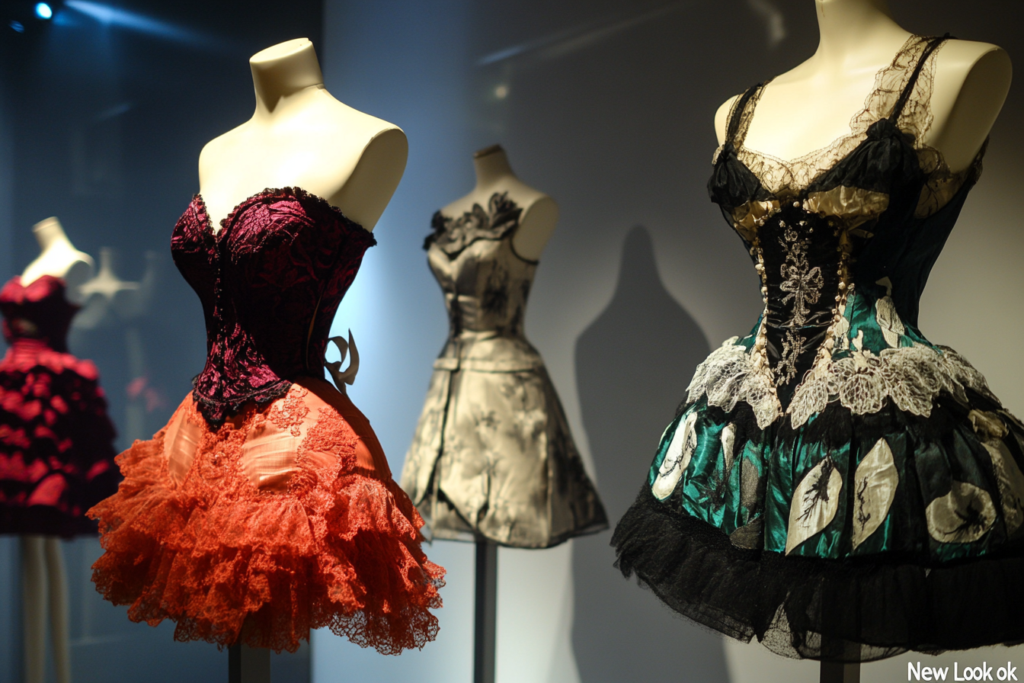Hourglass: The Iconic Silhouette in Fashion History
Meta Description: The hourglass silhouette, achieved through tight waist-cinching, highlights the hips and chest. Popular in the 19th century, it reemerged in Dior’s 1947 “New Look.”
What is the Hourglass Silhouette?
The hourglass silhouette is a fashionable body shape emphasizing a cinched waist, full hips, and a prominent bust. Historically, this look was achieved with corsets, structured garments, and padding to enhance natural curves.
This style was dominant in the 19th and early 20th centuries and experienced a dramatic revival with Christian Dior’s “New Look” in 1947, which reintroduced ultra-feminine waist-defining styles.


Key Features of the Hourglass Silhouette
✔ Narrow Waist – Created using corsets, girdles, or structured tailoring.
✔ Full Bust & Hips – Emphasized by draping, padding, or fitted bodices.
✔ Fitted Bodices & Flared Skirts – Creates a contrast between the waist and lower body.
✔ Structured Fabrics & Shaping Undergarments – Helps maintain the dramatic, sculpted look.
Historical Evolution of the Hourglass Shape
1. 19th Century: The Victorian Corseted Look (1800s – Early 1900s)
- Women wore tight corsets to create a small waist and accentuated hips and bust.
- Dresses featured full skirts, petticoats, and layers of fabric to enhance curves.
2. Edwardian Era: The “S-Bend Corset” (1900s – 1910s)
- A curved corset pushed the hips backward and chest forward, creating a dramatic hourglass curve.
- This era’s fashion was heavily restrictive and required structured undergarments.
3. Decline of the Corset & Flapper Fashion (1920s)
- Flapper dresses and straight-cut silhouettes rejected the hourglass shape.
- The boyish, loose silhouette became the new trend.
4. Dior’s “New Look” & The Hourglass Revival (1947)
- Christian Dior’s “New Look” collection reintroduced the exaggerated hourglass shape.
- Features included:
- Tightly cinched waists (often with corset-like belts).
- Full, voluminous skirts.
- Softly structured shoulders and fitted bodices.
5. The 1950s & Marilyn Monroe’s Iconic Hourglass Look
- Women embraced feminine, curvy styles with fitted waists and full skirts or wiggle dresses.
- Celebrities like Marilyn Monroe, Sophia Loren, and Elizabeth Taylor popularized this classic hourglass glamour.
6. Modern Influence: The Hourglass Figure Today
- Contemporary designers like Dolce & Gabbana, Zac Posen, and Vivienne Westwood continue to highlight the hourglass aesthetic.
- Shapewear, bodycon dresses, and structured tailoring keep the hourglass look relevant in modern fashion.
Famous Hourglass-Inspired Fashion Pieces
- Christian Dior’s “Bar Suit” (1947) – The epitome of the New Look hourglass silhouette.
- Marilyn Monroe’s Fitted Dresses (1950s) – Defined curves with wiggle dresses and cinched waist designs.
- Alexander McQueen’s Sculpted Gowns – Used boning and draping to enhance the hourglass effect.
- Kardashian-Style Bodycon Dresses – A modern take on waist-defining silhouettes.
How to Achieve an Hourglass Silhouette in Modern Fashion
✔ Corsets or Waist-Cinching Belts – Instantly enhance waist definition.
✔ Fit-and-Flare Dresses – Creates balance between the waist and hips.
✔ Peplum Tops & Skirts – Adds volume to the hips while maintaining a fitted waist.
✔ High-Waisted Bottoms – Emphasizes the waistline for a curvier effect.
✔ Structured Jackets & Tailored Pieces – Shapes the body with strategic seams and darts.
Hourglass Silhouette vs. Other Body Shapes
| Silhouette | Definition | Common Styles |
|---|---|---|
| Hourglass | Balanced bust and hips with a narrow waist | Fitted bodices, flared skirts, corsets |
| Pear-Shaped | Wider hips than bust | A-line skirts, off-shoulder tops |
| Rectangle | Waist, bust, and hips have similar measurements | Belted dresses, structured shoulders |
| Inverted Triangle | Broad shoulders, narrower waist and hips | Flowy skirts, V-necklines |
The hourglass shape remains a timeless beauty ideal, influencing fashion from couture runways to everyday street style.
Why is the Hourglass Silhouette So Iconic?
✔ Symbol of Femininity & Elegance – Seen as the ultimate figure of glamour.
✔ Defines Classic & Modern Fashion Trends – Influences runway couture and high-street fashion.
✔ Flattering for Many Body Types – Creates a balanced, proportional look.
✔ Endlessly Reinterpreted – Designers reinvent the hourglass silhouette every decade.
Conclusion: The Enduring Legacy of the Hourglass Silhouette
From Victorian corsets to Dior’s New Look and modern red carpet gowns, the hourglass silhouette has defined fashion for centuries. Whether through structured tailoring, shapewear, or figure-hugging designs, this timeless shape continues to dominate fashion trends and celebrate femininity.



